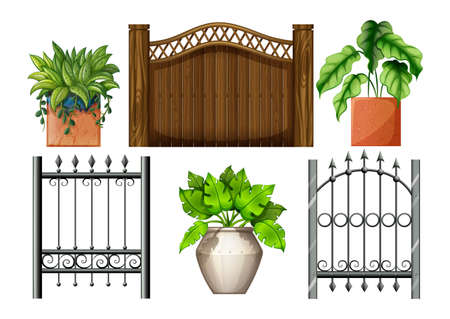Introduction to the Classic British Cottage Garden
The classic British cottage garden is more than just a planting style; it is a living piece of the UK’s cultural and horticultural heritage. Rooted in centuries-old rural traditions, these gardens first emerged around humble country cottages, where practicality and beauty went hand in hand. Originally, they combined ornamental flowers with edible plants, herbs, and fruit trees—making the most of limited space while adding vibrant colour and fragrance to daily life.
Today, the cottage garden remains a cherished part of British identity, beloved for its informal charm and relaxed planting schemes. The enduring popularity of this style stems from its ability to evoke nostalgia and create a sense of sanctuary. It is an approach that welcomes wildlife, encourages biodiversity, and celebrates the unique character of each individual garden plot.
Key Features of the Classic Cottage Garden
| Feature | Description |
|---|---|
| Informal Design | Curving paths and naturalistic planting without rigid structure |
| Mixed Planting | A blend of perennials, annuals, shrubs, herbs, and vegetables |
| Traditional Materials | Use of stone, brick, or picket fencing; rustic garden furniture |
| Wildlife Friendly | Plant choices that attract bees, butterflies, and birds |
The cottage garden style continues to inspire gardeners across the UK because it reflects both practical ingenuity and an appreciation for timeless beauty. Whether you’re tending a small urban plot or a sprawling country garden, embracing this tradition connects you to generations of British gardeners who have found joy in cultivating their own green sanctuaries.
Key Styles and Characteristics
When exploring the essence of a classic British cottage garden, several distinctive features define its enduring charm and practical appeal. Cottage gardens are celebrated for their relaxed, informal layout—a refreshing contrast to more regimented, formal designs. This informality is reflected in the naturalistic planting schemes, winding paths, and gentle mixing of plants, which together evoke a sense of timeless English countryside beauty.
Defining Features
| Feature | Description |
|---|---|
| Informal Layout | Paths meander rather than follow straight lines; flower beds have soft, irregular edges. |
| Rich Planting | Dense, layered plantings create a lush effect with little bare soil visible between specimens. |
| Ornamental & Edible Blend | Flowers, herbs, fruit bushes, and vegetables are grown side by side in harmonious combinations. |
Informality at Its Heart
Cottage gardens thrive on an unstructured design ethos. The planting is often spontaneous—think hollyhocks leaning over a pathway or foxgloves popping up where they please. This approach fosters biodiversity and encourages beneficial wildlife such as bees and butterflies.
A Rich Tapestry of Plants
One hallmark of the British cottage garden is its generous use of diverse plant species. Old-fashioned perennials like delphiniums, lupins, and peonies mingle with self-seeding annuals such as poppies and love-in-a-mist. Shrubs like roses and lavender provide structure, while climbers like clematis soften fences and walls.
The Harmony of Ornamentals and Edibles
Unlike many modern gardens that separate flowers from food crops, cottage gardens integrate both seamlessly. Marigolds may protect beans from pests, strawberries nestle beneath gooseberry bushes, and herbs like chives edge borders for both beauty and utility. This blend not only maximises space but also reflects a traditional British approach to gardening—where every inch serves both aesthetic and practical purposes.

3. Iconic Plants and Traditional Elements
When designing a classic British cottage garden, selecting the right plants and integrating timeless landscaping features is essential to capturing that nostalgic charm. Below, you’ll find some of the most beloved flowers, shrubs, and heritage varieties cherished by British gardeners, as well as traditional hard landscaping elements that bring authenticity to your outdoor space.
Classic Cottage Garden Plants
| Plant Type | Popular Varieties | Typical Features |
|---|---|---|
| Roses | English Rose, Old-fashioned Climbers | Fragrant blooms, romantic look, ideal for arches & trellises |
| Perennials | Lupins, Delphiniums, Foxgloves | Tall flower spikes, cottage colour palette, attract pollinators |
| Herbs & Edibles | Lavender, Chives, Mint | Scented foliage, culinary uses, informal planting style |
| Shrubs | Box (Buxus), Hydrangea, Philadelphus | Evergreen structure, seasonal interest, privacy screens |
| Annuels & Self-seeders | Poppies, Nigella (‘Love-in-a-mist’), Cornflowers | Cottage spontaneity, naturalised look, easy to grow from seed |
Traditional Landscaping Elements
- Picket Fences: White or natural timber picket fences are iconic in British cottage gardens. They provide gentle boundary definition without feeling too formal.
- Stone Pathways: Meandering stone or brick paths create a sense of journey through the garden while complementing the rustic style of period cottages.
- Rustic Trellises & Arches: Wooden or wrought iron structures support climbing plants like roses and clematis, framing entrances and providing vertical interest.
- Cottage Borders: Planting beds packed with a tapestry of textures and colours—often with little distinction between ornamental and edible plants—epitomise the informal charm of these gardens.
- Weathered Benches & Birdbaths: Simple seating and wildlife-friendly features add character and encourage you to linger among the flowers.
Embracing Heritage Charm
The true essence of a British cottage garden lies in its blend of vibrant planting and practical yet beautiful features. Use native species where possible for easy maintenance and to support local wildlife. Mix heights, colours, and textures freely—perfection is less important than creating an inviting retreat that feels both lived-in and loved.
4. Planning and Layout Tips
Designing a classic British cottage garden starts with thoughtful planning and an understanding of traditional layout principles. The goal is to create a space that feels informal yet harmonious, blending structure with abundant, natural planting. Below are practical tips to help you plan your gardens structure, define pathways, arrange flower beds, and create focal points that embody the timeless charm of the British countryside.
Establishing Your Garden Structure
A well-structured cottage garden often uses subtle design elements rather than strict formality. Start by mapping out your garden space on paper or using a digital tool. Define the boundaries with hedges or rustic fencing—popular choices include native hawthorn, hazel, or woven willow. Consider dividing the garden into smaller “rooms” using low box hedges or espaliered fruit trees for added interest and privacy.
Pathways: Practicality Meets Aesthetics
Traditional British cottage gardens feature winding paths that invite exploration while providing access for maintenance. Use local materials such as gravel, reclaimed bricks, or flagstones for authenticity and durability. Paths should be wide enough for easy passage but maintain a relaxed feel by avoiding rigid lines.
| Pathway Material | Advantages | Traditional Appeal |
|---|---|---|
| Gravel | Good drainage, informal look, easy to lay | High |
| Reclaimed Brick | Durable, classic appearance, eco-friendly | Very High |
| Flagstone | Sturdy, natural texture, ages beautifully | High |
| Bark Chips | Soft underfoot, naturalistic effect | Moderate |
Arranging Flower Beds and Borders
Cottage gardens are known for their densely planted borders brimming with perennials and self-seeding annuals. Lay out flower beds along paths and around seating areas to maximise colour and fragrance throughout the seasons. Plant in loose drifts rather than formal rows, mixing heights and textures to achieve a relaxed tapestry effect. Remember to leave access points for weeding and pruning.
Classic Planting Combinations:
- Lavender & Roses: For scent and romance along sunny borders.
- Delphiniums & Foxgloves: Add vertical accents at the back of beds.
- Poppies & Cornflowers: Scatter among lower-growing herbs for bursts of colour.
- Clematis & Honeysuckle: Train up arches or trellises for height and wildlife interest.
Create Inviting Focal Points
A successful cottage garden always includes features that draw the eye and encourage lingering. Classic options include a painted wooden bench nestled beneath an old apple tree, a weathered sundial, or a small wildlife pond edged with irises and forget-me-nots. Place these elements where they can be enjoyed from multiple angles or used as quiet retreats within the garden “rooms”.
Top Tip: Balance is key—avoid overcrowding by spacing focal points so each has its own presence without competing visually.
The right planning and thoughtful layout will ensure your British cottage garden captures both beauty and practicality—offering year-round interest in true English style.
5. Maintenance and Seasonal Care
Keeping a classic British cottage garden in top condition requires year-round attention and a keen eye for detail. Traditional cottage gardens are brimming with life, so regular maintenance is essential to preserve their charm and biodiversity. Below youll find practical guidance on pruning, deadheading, soil improvement, and supporting wildlife throughout the seasons.
Pruning and Deadheading
Pruning helps to encourage healthy growth, maintain shape, and improve air circulation among your plants. In spring, cut back any dead or damaged stems from perennials and shrubs such as roses and lavender. During summer, regular deadheading – removing spent flowers – will keep blooms coming and prevent self-seeding where not desired.
| Season | Task | Typical Plants |
|---|---|---|
| Spring | Prune back woody perennials; tidy up borders | Roses, Lavender, Buddleia |
| Summer | Deadhead flowers; trim hedges lightly | Geraniums, Sweet Peas, Hollyhocks |
| Autumn | Cut back faded perennials; collect seeds | Astrantia, Delphinium, Foxglove |
| Winter | Remove old growth; mulch borders | Shrubs, Hellebores, Ornamental Grasses |
Soil Improvement Techniques
The backbone of a thriving cottage garden is rich, well-conditioned soil. Annually in autumn or winter, dig in organic matter such as well-rotted manure or homemade compost to boost fertility and structure. Mulching in late winter will help retain moisture and suppress weeds come spring.
Supporting Biodiversity
A true cottage garden teems with beneficial insects, birds, and small mammals. Encourage pollinators by growing nectar-rich native plants like foxgloves and comfrey. Leave some seed heads through winter for birds to feed on. Consider leaving a log pile or wild corner to support hedgehogs and insects – an important part of British countryside tradition.
Key Biodiversity Tips:
- Plant a mix of single-flowered varieties for easy pollinator access.
- Avoid pesticides; use natural deterrents such as companion planting.
- Add a bird bath or small pond to create habitats for wildlife.
Seasonal Cottage Garden Checklist:
- Spring: Prune shrubs, plant hardy annuals, divide overgrown clumps.
- Summer: Deadhead regularly, water during dry spells (ideally with collected rainwater), monitor for pests manually.
- Autumn: Cut back perennials after flowering, add mulch, plant bulbs for next spring.
- Winter: Protect tender plants with fleece or cloches; clean tools ready for the new year.
Caring for your classic British cottage garden is an ongoing process that brings rewards every season. With thoughtful maintenance routines inspired by traditional practices and a commitment to encouraging biodiversity, you’ll ensure your garden remains a vibrant haven year after year.
6. Adding Personal Touches for Authenticity
One of the joys of designing a classic British cottage garden is the opportunity to infuse your outdoor space with a sense of local character and personal heritage. By incorporating regionally sourced materials, vintage ornaments, and UK-centric accessories, you can create a garden that feels truly authentic and uniquely yours.
Finding Inspiration in Local Materials
Using locally quarried stone for walls or reclaimed brick for pathways not only enhances the rustic charm but also grounds your garden in its geographical context. Consider regional woods for fences or arbors, such as English oak or chestnut, which weather beautifully and support native wildlife.
Examples of Regional Materials
| Region | Recommended Stone/Wood | Traditional Use |
|---|---|---|
| Cotswolds | Cotswold stone | Boundary walls, raised beds |
| Kent | Chestnut poles | Fencing, hurdles, trellises |
| Yorkshire | York stone | Paving, steps, patios |
| Lancashire | Sanded red brick | Pathways, edging |
Selecting Vintage Ornaments and Accessories
Cottage gardens are often enhanced by time-worn features that tell a story. Scour local antique fairs or salvage yards for old watering cans, wrought iron gates, sundials, and terracotta pots. Such items add instant history and evoke the quintessential British gardening spirit.
Popular Vintage Ornaments in UK Gardens:
- Weathered stone birdbaths or troughs planted with herbs or alpines
- Copper watering cans displayed among borders or hanging from arbours
- Mossy millstones repurposed as stepping stones or focal points
- Reclaimed wrought iron benches tucked into secluded corners for contemplation
- Vintage wooden wheelbarrows filled with seasonal blooms at the entrance gate
Celebrating Regional Character and Personal Heritage
A truly authentic cottage garden reflects not just its location but also the gardener’s story. Plant traditional flowers from your family’s past—perhaps sweet peas grown by a grandparent—or display mementos from local history. Add handmade signs using British calligraphy styles or install custom ceramic plaques celebrating important dates.
Ideas for Personalisation:
- Create a border dedicated to county-specific plants (e.g., Lancashire roses or Cornish bluebells)
- Use painted pebbles inscribed with local sayings or proverbs along paths
- Hang bunting made from recycled Union Jack fabric during village fêtes and summer parties
- Add nesting boxes crafted by local artisans to encourage native birds like robins and wrens
- Name your garden gate or bench after a beloved family member using hand-carved wooden signs
A classic British cottage garden gains true depth when it tells your story while honouring the traditions of its locale. By blending regional materials with cherished heirlooms and local craftsmanship, you ensure your garden is not only beautiful but brimming with authenticity and character.


